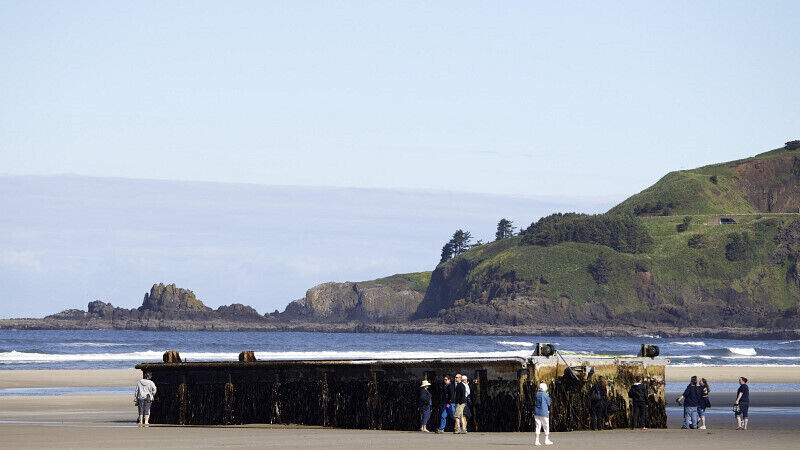Japan tsunami debris washes up on US beach

A nearly-70ft dock torn from a fishing port in northern Japan during the tsunami drifted thousands of miles across the Pacific Ocean and floated ashore on an Oregon beach.
A commemorative plaque on the dock showed it was one of four owned by Aomori Prefecture (state) that broke loose from the port of Misawa on the northern tip of the main island, Deputy Consul Hirofumi Murabayashi said from Portland.
"We were able to confirm from Aomori Prefecture that they don't wish to have it returned," he said. "About the other three, of course, we have no idea where they are floating, or if they are sunk somewhere."
The dock was first spotted floating offshore on Monday and mistaken by several people for a barge, said Chris Havel of the Oregon Department of Parks and Recreation. It washed ashore early on Tuesday on Agate Beach, a mile north of Newport on the central Oregon Coast.
It is made of concrete with a metal pontoon and is 66ft long, 19ft wide and 7ft high.
The distance between Japan and Oregon is about 5,000 miles.
A starfish native to Japan was among the marine life still clinging to the structure after the long voyage, Mr Havel said.
"This is tsunami debris, not just from Japan, but from the tsunami itself," he said.
Tom Cleveland, a housekeeping supervisor at nearby beachfront condominiums, said the dock washed ashore in a storm and people curious to see it have been jamming up traffic at a beach car park.
"Everybody and their brother has been here looking at it and checking it out," he said. "Obviously, we knew things would be coming our way but I didn't expect anything this size."
A radiation check of the dock proved negative, which was to be expected if the dock broke loose before the nuclear power plant accident triggered by the waves, Mr Havel said. The parks department was overseeing efforts to identify and remove the dock.
State police were posted to keep people from climbing on the dock, said Mitch Vance, shellfish programme manager for the Oregon Department of Fish and Wildlife, who took samples of the mussels, barnacles and other shellfish clinging to the dock. There also was green algae and brown kelp, he said.
There was no answer at the Tokyo-listed phone number for Zeniya Ocean Service Engineering, the company named on the placard, after business hours in Japan. The placard was dated June 2008.
The coastal town of Misawa, where the dock originated, sustained some tsunami damage but is north of the most heavily hit areas in Iwate and Miyagi states.
The bulk of the debris from the March 2011 tsunami is not expected until winter, but fast-moving examples have been arriving on North America's shores.
They include a football that washed up in Alaska and a shipping container holding a Harley-Davidson motorcycle with Japanese registration plates that turned up in British Columbia earlier this year.
US senator Ron Wyden called on the National Oceanic and Atmospheric Administration to redouble its efforts to track the debris, saying something as big as the dock could pose a danger to ships at sea.
Mr Havel said the department would be responsible for removing the dock, which remained on the beach yesterday. The plaque has been put in storage.
It was not yet determined whether the dock would be towed off the beach and floated somewhere for disposal, or cut up on the beach for removal.
In the meantime, small numbers of people have been coming to the beach to see the dock, but Mr Havel said: "I think that's going to change to large crowds."













